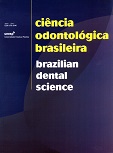Relação entre a prevalência da doença cárie e risco microbiológico
DOI:
https://doi.org/10.14295/bds.2008.v11i2.462Abstract
A cárie dentária é uma doença infecciosa, multifatorial com prevalência na infância, sendo a bactéria Streptococcus mutans principal agente etiológico, existindo uma correlação entre concentração desta na cavidade bucal e incidência da doença. Neste contexto, o trabalho objetivou relacionar incidência clínica da cárie, com concentração da bactéria na saliva de escolares, visando avaliar o risco à doença e implantar ações para seu controle. Foram realizadas avaliações de determinantes sócio-econômicos, dieta, condições clínicas e análise microbiológica da saliva. A partir da concentração de unidades formadoras de colônias (UFC/mL de saliva) em Agar Mitis Salivarius acrescido de sacarose e bacitracina;as crianças foram classificadas como alto, médio ou baixo risco de desenvolvimento à doença. Análise clínica baseada nos índices CPO-D, ceo-d e atividade de cárie foi realizada e os dados confrontados com a análise microbiológica. Um total de 237 crianças, na faixa etária de 5 a 12 anos foi avaliado. A partir dos dados clínicos, observou-se que 73% das crianças apresentaram alta prevalência de cárie, das quais 83,5% apresentaram alta concentração de S. mutans na saliva, verificando correlação bisserial por ponto, significativa entre a detecção do risco e a manifestação clínica da doença. Os resultados forneceram subsídios para ações de intervenção no processo saúde/doença.
Downloads
Downloads
Published
How to Cite
Issue
Section
License
Brazilian Dental Science uses the Creative Commons (CC-BY 4.0) license, thus preserving the integrity of articles in an open access environment. The journal allows the author to retain publishing rights without restrictions.
=================




























